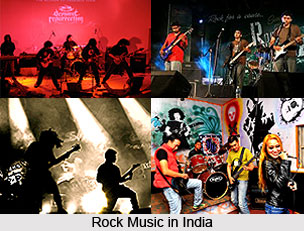"Music is the wine that fills the cup of silence" - Robert Fripp.
 What best can illustrate the feeling so very eloquently than that of the tuneful harmony of music which from the remote past has enchanted a million souls. Indian music, with its richness and opulence has further supported in manifesting the "unedited realities" of life in the most colossal way. Apart from the Hindustani Classics Indian music also boasts the rich presence of Rock & Metal music, which has not only added that tinge of contemporaneousness into Indian music but also aided in taking Indian music to the further level of mellowness.
What best can illustrate the feeling so very eloquently than that of the tuneful harmony of music which from the remote past has enchanted a million souls. Indian music, with its richness and opulence has further supported in manifesting the "unedited realities" of life in the most colossal way. Apart from the Hindustani Classics Indian music also boasts the rich presence of Rock & Metal music, which has not only added that tinge of contemporaneousness into Indian music but also aided in taking Indian music to the further level of mellowness.
Whilst the artistry of the Northern and Southern classical music formed the base of the Indian music it is with the very introduction of the rock & metal music that further contoured the structure of Indian music whilst giving birth to a number of bands and rock artists. The chronicle of Indian music unveils the verity that although the arena of rock & metal music in India was relatively small compared to the "Filmi music" yet its popularity was somewhat undeniable and is still ruling the artistry of Indian music with its sheer effervescence.
There have been rock movements in India especially in the metros like Mumbai, Delhi, Kolkata and Madras back in the year 1950s and continued to thaw the elite Indians with its entire sophistication. Generated, as an imitation of the western music traits, gradually Indian rock &Metal music became a whole new genre of music where the words like enthusiasm, rhythm and concord gained an articulate elucidation. Indian rock & metal music followed the long tradition of the club music that actually dominated India since the British left. The decade after the British period therefore can be marked as the "Rock N Roll Era". The anglicized and westernized young audience teamed with the anglicized officer class of the "Indian Army" became the new-fangled patron of the Indian Rock and metal music.
With the passage of time the extremely westernized Rock music of India acquired somewhat an oriental touch. With this and of course with the rationalization of the hang over of the European colonialism, it is during the early part of 80s India started producing her very own stylized rock & metal music. Although the seed of Rock music was sown during the British period yet it is during the late 80s and early 90s Rock & metal music in India gained that desired status. There developed a number of styles from soft rock to hard rock and metal. With the advent of MTV the 90s witnessed the emergence of a rather focused Rock& metal music. The legacy of the true rock n roll music of the 70s slowly came to an end and developed the harder style of rock & metal music as a result of the direct influence of the "Punk Style" and the "Thrash Style".
A million hearts thawed, a thousand lips quivered, A billion foot tapped - as it is in the later part of the 90s India developed her own Rock & metal music whilst unifying it with the originality of raga, Taal and Sur. This power trio ruled the Indian rock scene for quite a considerable period.
The recent Rock & metal music scenario in India is also quite impressive. The prospect of Rock music is not only promising but has also supported in carrying the contemporary Indian music to the next level while promoting Indian Rock Bands in the international market.




















